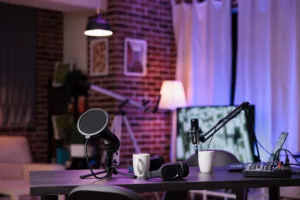When you purchase through links on our site, we may earn an affiliate commission. This doesn’t affect our editorial independence.
Starting a podcast doesn’t require maxing out credit cards. Despite what YouTube influencers suggest, quality podcasting equipment on a budget absolutely exists. The dirty secret? Many successful podcasters started with gear costing less than a fancy dinner. Here’s how you can get podcasting equipment on a budget.
Big-name podcasters love showing off their expensive mixing boards. But here’s reality: audio quality matters more than expensive labels. Smart equipment choices can deliver professional results without breaking the bank.
This guide cuts through marketing hype to reveal which podcasting equipment on a budget actually delivers value. No fluff, no affiliate link nonsense—just practical advice for getting started without financial stress.
Why Budget Equipment Makes Sense
Podcasting represents one of the most accessible media formats today. Unlike video production requiring expensive cameras and lighting, quality audio needs surprisingly modest investment. Good podcasting equipment on a budget can rival setups costing ten times more.
Many beginners make the mistake of waiting until they can afford “proper” equipment. This perfectionist trap prevents countless potential podcasters from ever starting. The truth? Audiences care far more about compelling content than pristine audio quality.
Setting up budget equipment offers several advantages. Lower initial investment means less financial pressure. Cheaper gear helps beginners learn without expensive mistakes. Most importantly, budget constraints force focus on content over technical perfection.
Essential Podcasting Equipments
 Every podcast needs four basic components: microphone, headphones, recording software, and audio editing capability. Everything else is optional luxury. Focus on these essentials first, then expand gradually.
Every podcast needs four basic components: microphone, headphones, recording software, and audio editing capability. Everything else is optional luxury. Focus on these essentials first, then expand gradually.
Microphones represent the most critical investment. Dynamic microphones work better than condenser mics for home recording because they reject background noise naturally.The Audio-Technica ATR2100x-USB offers both USB and XLR connections for less. The Samson Q2U provides similar versatility at comparable prices.
USB microphones simplify setup for beginners. Blue Yeti gets attention but costs more than necessary. Samson Go Mic delivers surprising quality for under $40. Audio-Technica ATR2500x-USB provides professional results at mid-budget prices.
Headphones matter more than most realize. Cheap earbuds miss crucial audio details during recording and editing. Sony MDR-7506 headphones remain industry standards after decades. Audio-Technica ATH-M40x offers similar quality at lower prices. Both cost under $100.
Closed-back headphones prevent audio bleed during recording. Open-back designs sound more natural but leak audio that microphones pick up. For podcasting equipment on a budget, closed-back models make more sense.
Free Software Podcast Production
Recording software doesn’t need to cost anything. Audacity remains the gold standard for free audio editing. It handles multi-track recording, noise reduction, and basic effects without subscription fees.
GarageBand comes free with Mac computers and offers more intuitive interfaces than Audacity. Hindenburg Pro costs money but many users find the investment worthwhile for its intelligent automatic features.
For remote interviews, platforms like Zencastr, Squadcast, and Riverside.fm offer free tiers. These services record each participant separately, preventing the audio quality issues that plague Zoom recordings.
Cloud storage becomes essential for backup and collaboration. Google Drive, Dropbox, and OneDrive all offer free storage tiers sufficient for most podcasting needs.
Advanced Budget Equipment Options
Audio interfaces expand recording possibilities once basic setups feel limiting. Focusrite Scarlett Solo provides single-input recording for under $120. Behringer UMC22 costs even less while delivering similar functionality.
Mixing boards seem intimidating but simple models like the Behringer Xenyx 502 cost under $50 and provide useful features like EQ and monitoring controls. These aren’t necessary for beginners but can improve workflow later.
Acoustic treatment improves audio quality more than expensive microphones. Moving blankets cost $20 and dramatically reduce room echo. Recording in closets full of clothes works surprisingly well. Proper acoustic treatment beats expensive gear every time.
Pop filters prevent plosive sounds that ruin recordings. Aokeo Professional microphone pop filters cost under $15 and work as well as expensive alternatives. Windscreens offer similar protection for even less money.
Smart Shopping for Podcasting Equipments
Used equipment markets offer excellent values for patient shoppers. Guitar Center, Sam Ash, and local music stores regularly sell returned or demo equipment at significant discounts. Facebook Marketplace and Craigslist contain hidden gems from upgrading podcasters.
Refurbished equipment from manufacturers comes with warranties while costing less than new items. Audio-Technica, Shure, and other major brands offer certified refurbished products through their websites.
Bundle deals sometimes provide better value than individual purchases. Podcast starter kits from reputable manufacturers often include everything needed at lower total costs than buying separately.
Avoid ultra-cheap Chinese microphones from Amazon. While some work acceptably, quality control varies wildly. Stick with known brands for microphones—the most critical component where quality matters most.
Common Mistakes with Budget Podcasting Equipment
Buying too much too soon wastes money and creates complexity. Start minimal, then add equipment as specific needs become clear. Many successful podcasters still use their original basic setups after years of production.
Focusing on specs instead of real-world performance leads to poor purchasing decisions. Frequency response charts matter less than how equipment sounds in actual recording environments. Read reviews from actual podcasters, not audio engineers.
Neglecting acoustic treatment while obsessing over expensive microphones makes no sense. Bad room acoustics ruin recordings from even the most expensive equipment. Good acoustic treatment makes budget microphones sound professional.
Copying favorite podcasters’ setups exactly ignores personal needs and budget constraints. What works for established podcasters with sponsors and revenue may not suit beginners with limited resources.
Getting Professional Results
Proper microphone technique matters more than microphone price. Maintaining consistent distance from the microphone, speaking directly into it, and avoiding handling noise improve audio quality more than expensive upgrades.
Recording environment affects quality dramatically. Quiet rooms with soft furnishings sound better than empty spaces with hard surfaces. Recording during quiet times of day eliminates unwanted background noise.
Post-production fixes many budget equipment limitations. Learning basic noise reduction, EQ, and compression techniques in free software like Audacity transforms amateur recordings into professional-sounding content.
Consistency beats perfection every time. Regular publishing schedules with decent audio quality build audiences faster than sporadic releases with pristine sound.
Building Your Budget Podcast Setup
Start with absolute basics: USB microphone, closed-back headphones, and free recording software. This minimal setup costs under $150 and produces acceptable results for most content types.
Add equipment gradually based on actual needs, not imagined requirements. Audio interfaces become useful when multiple microphones are needed. Mixing boards help when live monitoring becomes important. Acoustic treatment improves quality more than any single equipment upgrade.
Budget constraints force creative solutions that often work better than expensive alternatives. Necessity breeds innovation in podcasting equipment choices.
Making Your Budget Work
Quality podcasting equipment on a budget requires research, patience, and realistic expectations. Perfect audio isn’t necessary for successful podcasts—engaging content matters far more than technical perfection.
Start recording immediately with whatever equipment seems reasonable within your budget. Experience reveals actual needs better than speculation. Many successful podcasters discovered their eventual setups through trial and error, not careful planning.
The best podcasting equipment is the gear that gets used consistently. Expensive equipment sitting unused helps nobody. Budget gear that enables regular content creation beats premium setups that intimidate beginners into inaction.
Focus on storytelling, interview skills, and audience engagement rather than obsessing over audio specifications. Listeners forgive imperfect sound when content delivers value. They won’t forgive boring content regardless of pristine audio quality.







